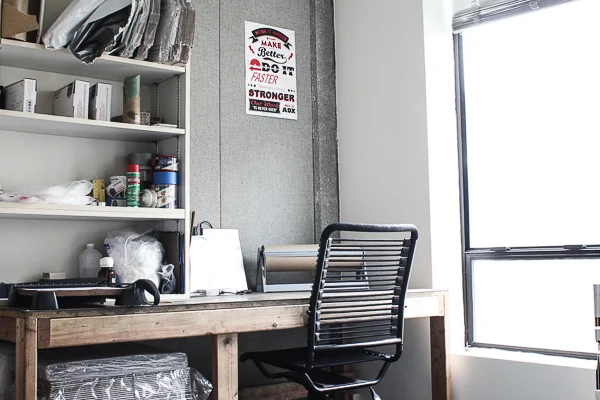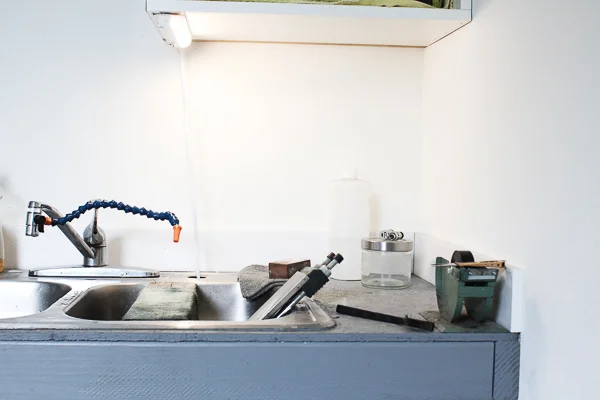We are proud to announce that our lead time on straight razor orders is now only three to four weeks!
Yes, you read that correctly. Our straight razor backorder is weeks, not months.
Making Straight Razors in SW Portland
This efficiency increase can be almost entirely attributed to the setup at our new workshop. In February we began the search for a larger, more permanent space in which to make our straight razors and strops. Thanks to the venerable Kelley Roy, owner of ADX, we were directed to the building we now call home. The former cabinet shop, located just a few blocks south of Downtown Portland, recently changed ownership and is currently being renovated to house other Portland Makers. We are fortunate enough to be the first tenants in the building and look forward to meeting our future neighbors. It took a few sleepless weeks of dust masks, epoxy paint, and bribing our dads to help us out, but we are very pleased with our new 1200 square-foot space!
Straight Razor Production Upgrades
Easily the most exciting result of our move: production is faster than ever! Lead times on our straight razors are currently three to four weeks, down from three to four months this time last year. The new shop affords us space to layout our straight razor manufacturing process and allowed us to invest in more sophisticated equipment. Much of what we’ve learned comes directly from sharing ideas with fellow makers (it is just better when you work together!). I hope other makers and creatives can learn from our experience. In no particular order, here are some of my favorite upgrades we have made to our shop to improve our straight razor output:
- Organization. One of the big selling points for the new shop is the natural, logical division of space. The warehouses we looked at prior to finalizing our decision were open-layout and would have been more effort (read: más money!) to build out. It also allowed us to separate ‘clean’ and ‘dirty’ operations, improving overall quality control. Believe me, there’s nothing worse than finding steel dust from grinding razors on your half-dried wood finish. Having these divisions in place also means we can set up our old work benches and optimize them for specific tasks. Which helps create…
- Orderliness. Far better than our old multi-multi-multi-purpose work table, each step in our straight razor production process has a dedicated station. Raw steel waits by the door to go to waterjet, straight razor blanks go by the grinders. Scales materials stay by the laser-cutter and laser-cut blanks are stored on the assembly station. We have a sink dedicated for sharpening straight razors and an anvil on a stand closeby for assembling a straight blade into scales immediately after. Leather and poly-webbing are stored inside our sewing table and strop hardware is within an arm’s reach. Relevant tools are stored at each station, and each station has its own set of tools. This one was especially helpful to me, since I tend to forget where I set things down.
- Visual Inventory. This ties in with having dedicated stations for each step. Visual inventory just means that all materials and parts are prominently on display. This lets you know when you need to make more of something or order more material. One forgets how quickly you go through 500 brass washers until you’re down to 5 and you really, really need 6 of them...
- Batch Production. Straight razors in production are done in batches of four and travel in a box from station to station. The order number, straight razor model, straight razor scales material, and other straight shaving add-ons in the order are printed and slipped into a cardholder on the lid of each box. This way, we always know exactly what needs to be done to complete an order. This saves time mapping out our day, we don’t check the master list as often, and assures that orders are constantly going out the door rather than languishing at a particular station for days. The 4-8 straight razor batch size seems to be our sweet spot, being able to move quickly while guaranteeing standards of quality are met at each step.
- Automation. We have invested in a few pieces of equipment that have majorly slashed our production time. We have written before about using our Laser Cutter and Thermark to brand our razors. Our Laser Cutter also cuts templates, cuts prototype parts, and engraves our straight razor boxes. Being able to cut out a custom part in seconds is a very powerful thing if you know your way around CAD. We also purchased a clicker press. It is basically a terrifying cookie cutter. Before the clicker press, we would painstakingly cut out strop pieces by hand: first the basic shape with a rotary cutter, then the internal corners with a chisel, then the hardware holes with a hand punch. The clicker press makes very quick work (about 2 seconds!) of cutting out our strop components.
- Error Proofing/Quality Control. Bad things happen fast, good things happen slowly. Having quality control steps built into the straight razor production process helps us achieve balance in making the best straight razor or strop possible, while getting it out the door in a reasonable timeframe. Work at every station starts and ends with a quality control step to guarantee that every batch of straight razors and strops meets our high standards. Each batch passes through multiple hands between steps, getting fresh eyes on the product and catching errors well before it gets to final assembly. If a straight razor doesn’t look exactly right, it’s far better to stop the line and take it back a step than to try and fix it after everything has been put together
- Friday, Fun Day! We dedicated our Fridays to shop improvements, process innovations and experiments for a couple reasons.
- First, it forces us to finish projects outside of normal straight razor production- things that are too new or risky for a normal day. This can be hanging a bike rack, setting up garbage and recycling systems, setting up lighting for our product photography corner, or nabbing great stuff from free piles around Portland (our huge cutting table was rescued from it’s destiny in a landfill on the corner of SE 3rd and Morrison). Other projects usually take the form of custom straight razors that require developing new techniques or build on our existing skillset. Each of these straight razors is a unique work of art unlike anything in our production line. These have resulted in some of our best work so far, and can be seen on our in-stock customs page.
- Second, it helps us grow. Decorating a retail space, fabricating a new straight razor display, programming the laser-cutter, experimenting with gold plating… every project presents a challenge and an opportunity to learn. They frequently take a left turn and become something completely different from what we imagined, but that’s another fun part of the the process and why we insist on making time for it. You never know what might come of it!
- Third, it keeps things fresh and interesting. The core straight razor production process--though much refined--has remained largely unchanged over the past three years. Although I’ve gotten much faster and more consistent at it, surface grinding my 500th straight razor felt a lot like my 50th… it’s hot, sweaty, dirty work. Knowing I get to try something new at the end of the week is a great motivator for me when work starts feeling repetitive.
- In Short: It’s a fun way to grow individually and as a company, constantly improving and staying relevant.
I’m sure a lot will change in the coming years, but I can say with confidence that it will only get better. The focus has always been--and will continue to be--on making the best American-made straight razors we can and providing you with essential straight shaving knowledge.
With a bit more time on our hands, I’ll be attempting to create more content for the blog, videos, and tutorials. Keep your eyes open here and subscribe to our YouTube channel for updates. If you’d like to see a blog post or a video about something, let us know in the comments!
Follow, like, subscribe!
Youtube
In our last shop, this work table was used for scales assembly, finishing scales, razor assembly, razor honing, etching straight razors, packaging finished razors, shipping, and sometimes eating lunch. Now it is dedicated to packaging and shipping.




